Facilitation of saccadic eye movements by postsaccadic electrical stimulation in the primate caudate
- PMID: 17167079
- PMCID: PMC6674951
- DOI: 10.1523/JNEUROSCI.3688-06.2006
Facilitation of saccadic eye movements by postsaccadic electrical stimulation in the primate caudate
Abstract
Sensorimotor experience followed by positive feedback leads to motor learning. Although the striatum, an input channel of the basal ganglia, has been implicated to play a key role in motor learning, little is known about how reward information modulates the neuronal processes in the striatum that causes behavioral changes. Here, we report that direct manipulation of the neuronal signal in the primate caudate yields behavioral changes comparable with those induced by natural reward. Electrical stimulation in the oculomotor region of the caudate immediately after saccades to a fixed direction led to selective facilitation of saccades in that direction. The facilitation remained even after stimulation was stopped, indicating a plastic change. These effects were observed when stimulation was applied after, not before, saccades. We propose that the caudate plays a causal role in behavioral changes by integrating selective sensorimotor and reward information in a temporally specific manner.
Figures
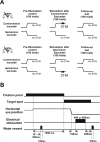
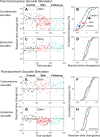

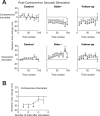
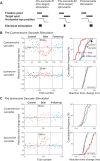

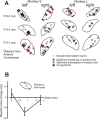
Similar articles
-
Saccade suppression by electrical microstimulation in monkey caudate nucleus.J Neurosci. 2010 Feb 17;30(7):2700-9. doi: 10.1523/JNEUROSCI.5011-09.2010. J Neurosci. 2010. PMID: 20164354 Free PMC article.
-
Effects of caudate microstimulation on spontaneous and purposive saccades.J Neurophysiol. 2013 Jul;110(2):334-43. doi: 10.1152/jn.00046.2013. Epub 2013 May 1. J Neurophysiol. 2013. PMID: 23636720
-
Correlation of primate caudate neural activity and saccade parameters in reward-oriented behavior.J Neurophysiol. 2003 Apr;89(4):1774-83. doi: 10.1152/jn.00630.2002. J Neurophysiol. 2003. PMID: 12686566
-
Role of the basal ganglia in the control of purposive saccadic eye movements.Physiol Rev. 2000 Jul;80(3):953-78. doi: 10.1152/physrev.2000.80.3.953. Physiol Rev. 2000. PMID: 10893428 Review.
-
Movement Vigor as a Reflection of Subjective Economic Utility.Trends Neurosci. 2019 May;42(5):323-336. doi: 10.1016/j.tins.2019.02.003. Epub 2019 Mar 13. Trends Neurosci. 2019. PMID: 30878152 Free PMC article. Review.
Cited by
-
Evidence for a task-dependent switch in subthalamo-nigral basal ganglia signaling.Nat Commun. 2017 Oct 19;8(1):1039. doi: 10.1038/s41467-017-01023-3. Nat Commun. 2017. PMID: 29051496 Free PMC article.
-
Reward signals in the motor cortex: from biology to neurotechnology.Nat Commun. 2025 Feb 3;16(1):1307. doi: 10.1038/s41467-024-55016-0. Nat Commun. 2025. PMID: 39900901 Free PMC article. Review.
-
The role of the dorsoanterior striatum in implicit motivation: the case of the need for power.Front Hum Neurosci. 2013 Apr 19;7:141. doi: 10.3389/fnhum.2013.00141. eCollection 2013. Front Hum Neurosci. 2013. PMID: 23626531 Free PMC article.
-
Saccade suppression by electrical microstimulation in monkey caudate nucleus.J Neurosci. 2010 Feb 17;30(7):2700-9. doi: 10.1523/JNEUROSCI.5011-09.2010. J Neurosci. 2010. PMID: 20164354 Free PMC article.
-
Caudate Microstimulation Increases Value of Specific Choices.Curr Biol. 2017 Nov 6;27(21):3375-3383.e3. doi: 10.1016/j.cub.2017.09.051. Epub 2017 Oct 26. Curr Biol. 2017. PMID: 29107551 Free PMC article.
References
-
- Barnes TD, Kubota Y, Hu D, Jin DZ, Graybiel AM. Activity of striatal neurons reflects dynamic encoding and recoding of procedural memories. Nature. 2005;437:1158–1161. - PubMed
-
- Bevan MD, Smith AD, Bolam JP. The substantia nigra as a site of synaptic integration of functionally diverse information arising from the ventral pallidum and the globus pallidus in the rat. Neuroscience. 1996;75:5–12. - PubMed
-
- Bruce CJ, Goldberg ME. Primate frontal eye fields. I. Single neurons discharging before saccades. J Neurophysiol. 1985;53:603–635. - PubMed
-
- Bursten B, Delgado JM. Positive reinforcement induced by intracerebral stimulation in the monkey. J Comp Physiol Psychol. 1958;51:6–10. - PubMed
-
- Calabresi P, Pisani A, Mercuri NB, Bernardi G. The corticostriatal projection: from synaptic plasticity to dysfunctions of the basal ganglia. Trends Neurosci. 1996;19:19–24. - PubMed
Publication types
MeSH terms
Grants and funding
LinkOut - more resources
Full Text Sources
